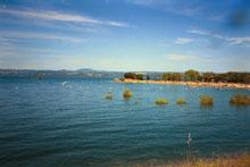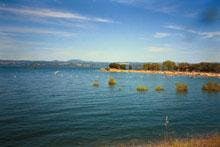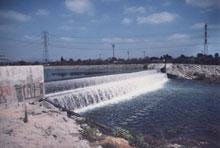Court rules regional agency can manage groundwater storage space
By Paeter Garcia
California is among several US western states facing water-related decisions today that will profoundly affect future generations. Among issues concerning water rights, water quality, and sufficient infrastructure, overall water supply is a concern being voiced by the courts, the legislature, environmental groups, and citizens at large. The question is simple: Will we have enough water to serve the growing population?
Clearly, effective water resource management helps shape the answer to that question, an edict that applies as much in California as it does in any other part of the world. Particularly in California, however, groundwater management has been the focus of intense debate and controversy, where one-third of the state's water demands are served by groundwater.
Historic over-production from groundwater basins has caused severe "overdraft" conditions in many parts of the state. Overdraft occurs where, over a continual period, the amount of groundwater extracted from a basin exceeds the amount of replenishment, which ultimately renders the supply insufficient to meet the needs of rightful users. Many overdrafted basins are now regulated according to stipulated groundwater right judgments or local groundwater management plans. The upshot of groundwater overdraft issues is that natural groundwater resources must be preserved and alternative resources must be maximised in order to ensure a sustainable water supply.
Solutions are being crafted to support the highest and best use of alternative resources. Water re-use, recapture, and recycling programs are stabilising the demand for potable water, desalination projects are being piloted up and down the Pacific coast, and water conservation is becoming the rule rather than the exception. At the heart of these solutions is an approach known as "conjunctive use." Generally, conjunctive use has been referred to as the integration of surface and subsurface resources to maximise water supply and cost efficiency. Typically, these programs involve either substitution of surface water in lieu of groundwater pumping, or underground storage of surplus surface water in wet periods for subsequent withdrawal in times of scarcity. The physical process of underground storage is achieved by forcing surface water into available subsurface storage space through percolation ponds or injection wells. Not surprisingly, therefore, underground storage capacity is a key ingredient to successful conjunctive use programming.
In California, conjunctive use projects involving groundwater storage have become increasingly desirable (if not necessary) as California's allotments of Colorado River water gradually decrease, environmental requirements steadily increase, and development of above-ground storage reservoirs remains problematic. Such groundwater storage projects raise the legal question of who controls or manages available storage space in groundwater basins. A California appellate court answered that question in a 12 June 2003 decision involving the Central Groundwater Basin in Los Angeles County.
The Central Basin underlies approximately 275 square miles of a southwestern portion of Los Angeles County. Historically, the Basin was relied upon as a water supply for agricultural, domestic, and industrial development. However, by the 1950s, the Central Basin was severely overdrafted and serious problems emerged. Critical water resources were depleted and a significant portion of the remaining supply was contaminated by "seawater intrusion," a condition that occurs where the groundwater table is drawn down below sea level and seawater migrates into the basin's fresh water supply.
A two-pronged approach was crafted to address these problems in the Central Basin. First, in 1959, the local water associations secured voter approval under state legislation (the Water Replenishment District Act, Cal. Water Code Section 60000 et seq.) to form the Water Replenishment District of Southern California ("WRD"). WRD's primary purpose was to serve as the permanent regional agency charged with securing artificial replenishment water and storing it in the Central Basin and the neighbouring West Coast Basin for future use. Second, WRD filed a water rights "adjudication" in the Los Angeles Superior Court. In 1965, that action resulted in a stipulated agreement (the "Judgment"), which establishes and limits the parties' rights to extract natural groundwater from the Central Basin.
Recognising that a successful groundwater replenishment effort requires a broad water management authority, the state legislature expressly authorised WRD to "do any act necessary to replenish the groundwater of said district." (Cal. Water Code § 60220.) Within that broad grant of authority, WRD is expressly empowered to carry out myriad activities, including, but not limited to storing water within its territory; augmenting local water supplies; establishing contracts that allow producers to use imported water in lieu of groundwater pumping; constructing and operating spreading grounds, conduits and other waterworks; acquiring water and water rights; levying assessments, charges and taxes to carry out its functions; and conducting technical and other investigations. (Cal. Water Code § 60230.)
WRD is further authorised to transport, recapture, recycle, purify, treat or otherwise manage and control water for the beneficial use of persons or property within its territory (Cal. Water Code § 60221(e). Indeed, conferring such authority on WRD has resulted in substantial recovery of the Central Basin. For the past forty-two years, WRD has restored over 250,000 acre-feet of water to regional storage.
Yet, given the magnitude of previous overpumping in the Central Basin, as much as 650,000 acre-feet of "dewatered storage space" exist in the Basin. In August 2001, thirteen of the major groundwater right holders in the Basin filed a motion to amend the Central Basin Judgment in a way that would have proportionately allocated all of the available subsurface storage space in the Basin to only those parties that hold adjudicated water rights under the Judgment (the "Storage Motion"). In October 2001, the trial court denied the Storage Motion under its continuing jurisdiction to administer the judgment. The Second District Court of Appeal upheld the trial court's ruling in the action entitled Central and West Basin Water Replenishment District vs. Adams, et al. Before addressing the merits of the case, the Court of Appeal broadly ruled that subsurface storage space in a groundwater basin is a public resource. Thereafter, in upholding the trial court's decision, the Court rejected several arguments made by the groundwater right holders.
First, the Court determined that storage rights in the Central Basin could not be established according to the doctrine of mutual prescription, as the water right holders had not continuously used the subsurface storage space, which is one of the elements of that doctrine. Next, the Court disagreed with the argument that storage rights necessarily attach to adjudicated water rights, stating: "Extraction and storage are different physical processes; establishing a hydrologic link between them is not sufficient to show that a legal interest in one creates an interest in the other." The Court also held that the "carryover rights" provided in the Judgment (the right to defer a limited percentage of one's extraction rights until the following year) do not confer ownership rights to the Central Basin's entire subsurface storage space.
Last, the Court held that the California legislature had empowered WRD to store water and to exercise management authority over the storage space in the Central Basin for replenishment purposes and for conjunctive use projects. In that regard, the Court held that "the Legislature also granted WRD authority to 'manage and control water for the beneficial use of persons or property within the district.' This broad power necessarily encompasses management of at least some portion of the storage space because the water WRD is authorised to manage and control is located in the Basin's storage space."
The Central Basin decision is helpful in affirming that available subsurface storage space should be managed as a public resource through a local yet centralised authority - an affirmation that can pay dividends in several respects. For instance, greater potential to facilitate groundwater storage projects may exist in a basin that is centrally managed by a public authority with accountability for water quality, quantity, and administrative costs. Moreover, a managed structure for groundwater storage can add more certainty to local and regional analyses concerning available water supplies, an advantage that may assist developers in satisfying California's new water supply requirements under SB 221 and SB 610.
Author's NotePaeter Garcia practices in the Water Resources and Land Development Groups at Weston, Benshoof, Rochefort, Rubalcava & MacCuish,LL in Los Angeles, California, U SA. Weston Benshoof provides water-related counselling and legal services to public agencies, private water companies, residential developers, and other clients involving water rights and supply, groundwater management, conjunctive use and watershed development. He can be reached at Weston Benshoof (310.712.1155)or by email: [email protected].


